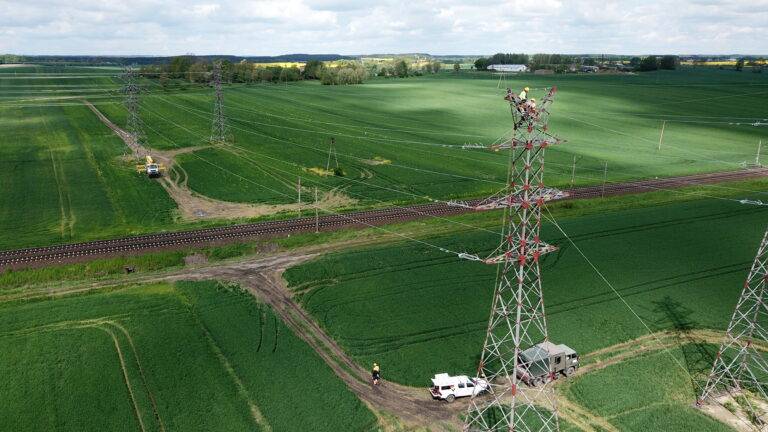Drones | Dragging an initial line over the Nogat River, Pelplin – Malbork, Poland
Using a drone to drag an initial line on 110 kV power line over the Nogat River, Pelplin – Malbork

On that day we had a job planned to stretch a thin link cable using an unmanned aerial vehicle (drone) between towers 88 and 89 on the Nogat River. A standard task – we have done this at Eltel Networks more than once. However – while the link cable was being stretched – unexpectedly a strong wind started blowing from the south. This made our work very difficult and could have posed a real danger to both the drone and the neighbouring 400 kV line, as the wind was pulling the stretched cable hard towards the active 400 kV line going in parallel. Fortunately, the enormous experience of the operator and the help of the crew enabled us to successfully complete this difficult and demanding task.
Łukasz Dubicki
Geodetic Surveyor
Unmanned Aircraft Specialist
Eltel Networks Energetyka SA
FACTS
Investor: Energa Operator SA, Gdańsk Branch
Location: Malbork and Tczew poviats
Completion: 2020
LINE DETAILS
- 110 kV line
- 25 km of line, including 1 km of quadruple cable line from Pelplin substation, then two double-circuit overhead lines between towers 1-20 and a single double-circuit overhead line from tower 21 to 98
- 98 towers (including types: dead-end, suspension, termination)
- line connection from the new 400(220)/110 kV substation in Pelplin
CHALLENGE
Our task was to use a drone, i.e. an unmanned aerial vehicle, to stretch a thin link cable between lattice towers 88 and 89 above the Nogat River. Then, the phase and lightning conductors were to be pulled, using this link cable.
Using traditional methods from the ground was not possible in this case because:
- wires had to be pulled over the Nogat River
- behind the Nogat, on the eastern side, there was a high, steep and heavily overgrown slope, which made working from the ground very difficult, if not impossible
Therefore, Eltel Networks approached the challenge in an innovative way and used a drone to stretch the thin link cable. This made it possible to pull a total of 8 wires, i.e. six phase conductors and two lightning protection wires. Our innovative drone solution allowed us to carry out the work commissioned by the client in an efficient and safe manner, as well as significantly reducing investment costs (e.g. associated with the rental of a helicopter).
EFFECT
The final result of our work was to hang 8 cables for 8 conductors (phase and lightning protection) in span 88-89 over the Nogat River. This, in turn, made it possible to carry out further work and to pull further wires using the traditional method in the remaining spans of sections 87-91.
The experience gained shows that the use of a drone in the electricity industry is an excellent alternative when traditional methods fail and brings a number of tangible benefits to the client:
- ability to mobilise quickly and take up an assignment
- non-shutdown technology work
- working on lines with different voltages
- much lower costs than using a helicopter
- no risk to human life
- no heavy equipment involved
- no need to enter the area
- possible work in difficult terrain (rivers, lakes, wetlands, areas with difficult access, urbanised areas or dangerous sites)




